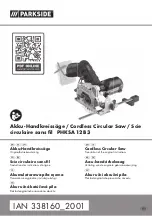
Powercraft
9
•
Be especially careful when sawing large, very small or
awkwardly shaped workpieces.
•
Be careful when double mitring.
•
Use additional supports (tables, trestle or other)
for long workpieces, which will otherwise topple
from the machine table if they are not held.
•
Do not use the machine to saw workpieces which
are so small that they can no longer be held safely.
•
When sawing profile sections, work must be car-
ried out so that the workpiece cannot slide away
and the saw blade cannot become jammed. A pro-
filed workpiece must lie flat or be held by an auxi-
liary tool, as a result of which toppling or sliding
during work is prevented.
•
Round workpieces such as pipes must be secu-
red, otherwise they will turn and there is a danger
that the saw blade will become jammed. Always
secure the workpiece against the check and on
the table, using a suitable auxiliary tool.
•
There may be no nails or foreign objects in the work-
piece to be treated.
•
In order to prevent damage to the ears, ear mufflers
must be used.
•
In order to prevent accidents in case the machine is
switched on by mistake, the mains plug must be
removed from the power point before adjustments
are made to the check or saw head. The same applies
to changing the saw blad or accessories and during
maintenance of the machine.
•
In order to prevent electric shocks, when connecting
the plug to the power point, the metal pins may not be
touched in any way whatsoever.
•
Do not use the cable to remove the plug from the
power point. Protect the cable from oil, heat and
sharp edges.
•
Never apply a detergent or lubricant to a saw
blade which is still rotating.
•
In order to prevent fire, the machine may never
be used near inflammable liquids, vapours or
gases.
•
Prevent injuries which can occur by not using the
original accessories. Only use the recommended
saw blades.
•
Choose a saw blade in relation to the material to
be sawn.
WHEN THE MACHINE IS IN OPERATION
Do not allow routine, which occurs when using the
machine frequently, to lead to mistakes. Remem-
ber that a slight lack of concentration can result in serious inju-
ries in a split second.
1. Ensure that the saw blade protective cap is in the cor-
rect position before you start sawing.
2. Before the first saw cut is made, allow the machine to
rotate for a while. Should unusual noises or strong
vibrations be observed, then switch off the machine
and remove the plug from the power point in order
to then determine the cause. Do not switch the
machine on before the cause has been established
and the fault has been remedied.
3. Make sure that the sawn off workpiece does not
become jammed, do not hold it, do not clamp it and
do not secure it against the check. It must be allowed
to move freely along the side of the saw blade. If these
conditions cannot be met, the sawn off workpiece
can be caught by the saw blade and flung away.
4. Avoid placing your hands in an unfavourable place,
whereby one or both hands may come into contact
with the saw blade as a result of a sudden displace-
ment.
5. Before you begin sawing, allow the saw blade to reach
its full revolutions.
6. Press the saw head downwards in such a way that the
motor is not overloaded and the saw blade is not jam-
med.
7. If you are going to remove jammed material, first
allow the saw blade to come to a standstill. Switch off
the saw and remove the plug from the power point.
8. After finishing the sawing process, hold the saw head
downwards, release the switch and wait until all the
moving parts have come to a halt, before you move
your hands away from the machine.
MOTOR
In order to prevent damage to the motor, chips and
dust must regularly be removed from it, in order to
ensure an ideal cooling.
1. Connect the machine to a 220/230V circuit.
2. If the motor does not start, the switch must be released
immediately. Remove the plug from the power point.
Check whether the saw blade can move freely. If the saw
blade moves freely, start the machine again.
3. If the motor suddenly stops during sawing, the switch
must be released immediately. Release the saw blade
from the workpiece, after which sawing can be conti-
nued.
4. When using long cables with too small a diameter, a
loss of voltage occurs, which gives problems with the
motor.
•
By a length of cable up to 15 meters, a diameter of
1.5 mm
2
must be used.
•
By a length of cable from 15 to 40 meters, a diame-
ter of 2.5 mm
2
must be used.
IMMEDIATELY SWITCH OFF THE MACHINE
WHEN
•
Interruption in the mains plug, mains lead or mains
lead damage.
•
Defect switch.
•
Smoke or stench of scorched isolation.
4
Powercraft
























